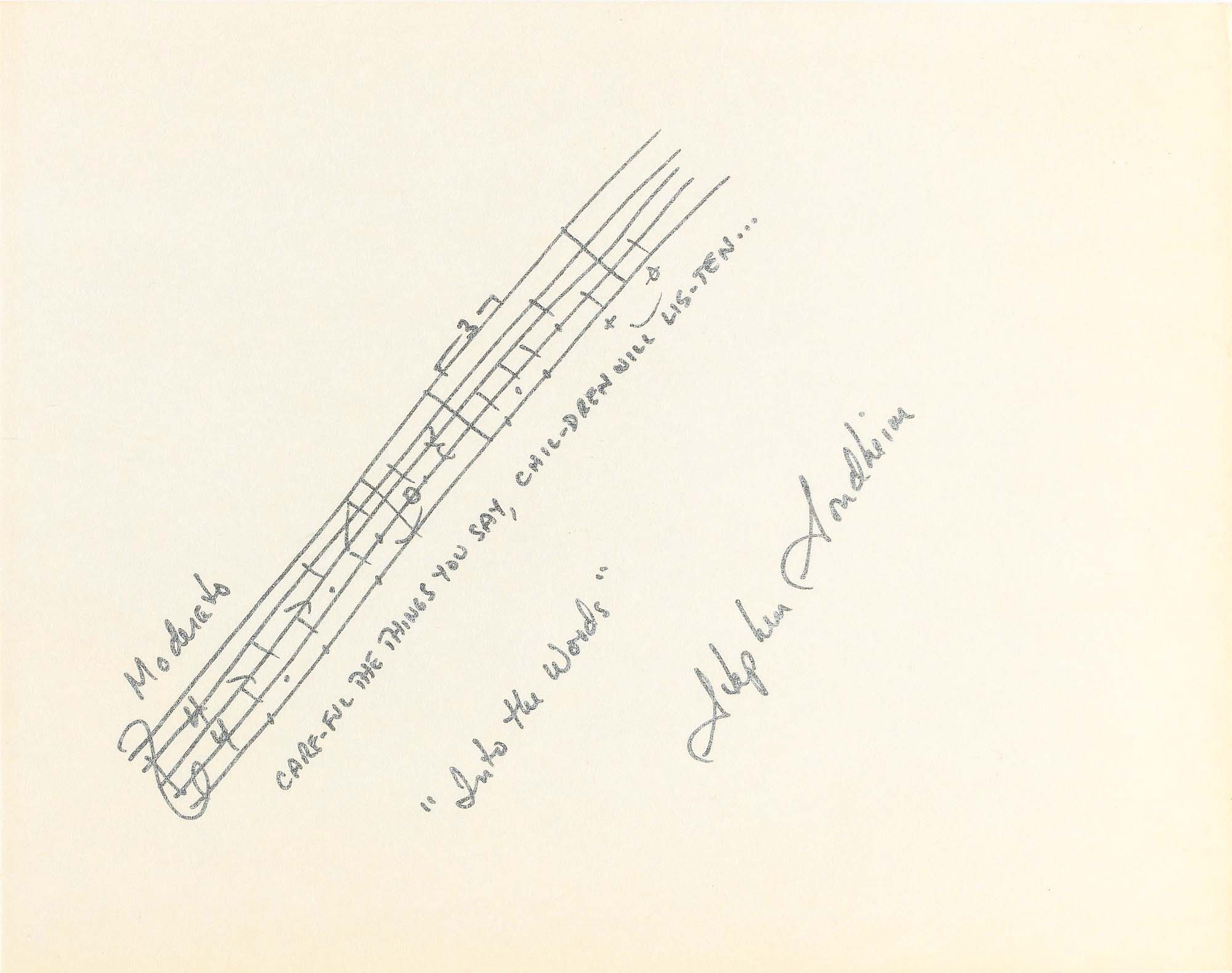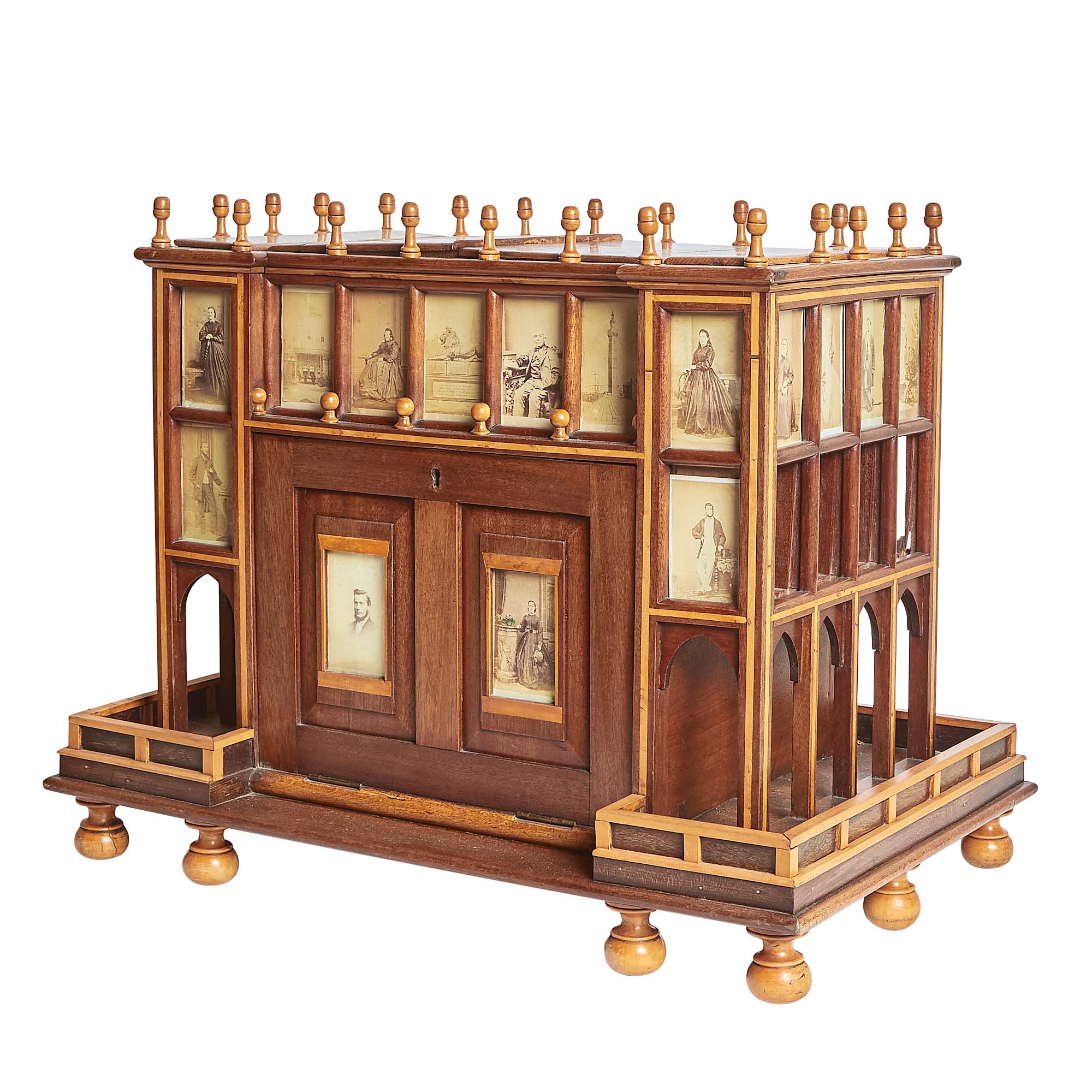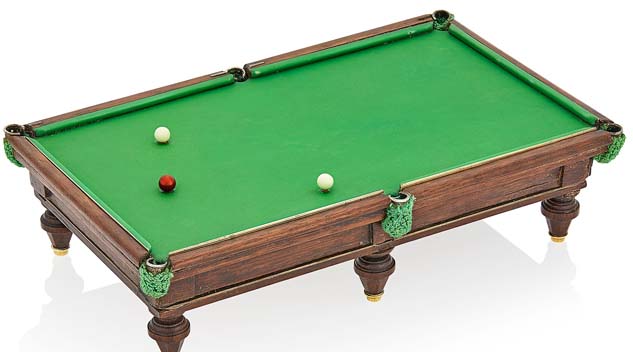#White #Glove #Sondheim #Sale #Totals #Million #Doyle #Antiques #Arts #Weekly

Closing the lid at $70,350 was this Fabergé enameled silver-gilt and wood covered box in the shape of a billiards table. Made between 1908 and 1917 by workmaster Karl Armfelt in St Petersburg, Russia, it measured 2 inches high, 4¾ inches wide and 7¾ inches long ($12/18,000).
Review by Kiersten Busch
NEW YORK CITY — On June 18, Doyle auction house conducted its sale of the Stephen Sondheim collection, which totaled more than $1.5 million. What the firm called a “landmark sale” sold all 454 lots offered — also known as a “white glove” sale — which hailed from Sondheim’s Manhattan townhouse and his country home in Roxbury, Conn. Sondheim was a lyricist and composer for well-known Broadway productions such as West Side Story, Gypsy, Company, Follies, Sweeney Todd, Sunday in the Park with George, Into the Woods and many others. “It was an amazing experience, really attributed to the wonderfulness of Sondheim’s fans, who came out in droves for the auction,” Peter Costanzo, director of rare books, autographs and photographs for Doyle shared with Antiques and The Arts Weekly. More than 1,000 people drawn to the auction through the firm’s exhibition of the collection, another 1,000 registered bidders through various platforms and a packed house of around 200 people on the day of the sale. The audience mostly hailed from the United States, with a number of English fans throwing in their bids as well. “There was competitive bidding on all lots, and we sold all of them. It was a remarkable feeling to be associated with such a powerful auction,” explained Costanzo.
Leading the day was a Fabergé enameled silver-gilt and wood covered box in the form of a billiards table, which soared past its estimate of $12/18,000 to achieve $70,350. The Fabergé box was designed by workmaster Karl Armfelt in St Petersburg, Russia, around 1908-17. The hinged top of the box was enameled to simulate green baize, contained three enameled balls and opened to reveal a silver-lined compartment. It was previously exhibited at the Cooper-Hewitt Museum in New York City from April 22 to May 21, 1983, and appeared in literature accompanying the exhibition. “This piece was very rare for Fabergé,” explained Costanzo, “it was considered a piece of Fabergé furniture even though it’s a miniature. It really spoke to Sondheim’s collecting taste; he loved moveable and transformable objects and furniture…he was a very inquisitive mind, and this piece reflected that.”

Sondheim’s gold record for the soundtrack to West Side Story from circa 1961, measuring 22 by 18 inches, realized $44,800 against a $1/1,500 estimate.
Closing out the top three best-selling lots of the sale were Sondheim’s gold Columbia Masterworks records for the West Side Story soundtrack and its Broadway cast recording, which realized $44,800 and $28,800 respectively. These were Sondheim’s first gold records, both awarded to him circa 1961, for sales of more than 1 million LP records for each. The gold record for West Side Story’s soundtrack was mounted above printed text that read “To Stephen Sondheim/In Commemoration of Sales/Over One Million Dollars/for the/Columbia Long Playing Record/West Side Story/Original Sound Track Recording”; the cast recording record displayed a similar message.
More Broadway-related items included three manuscript musical quotations, two from Into the Woods and one from Passion. All three, written in different colored inks, were signed by Sondheim and measured 11 by 14 inches. The highest selling of the three, earning $25,600, was an Into the Woods quotation, which included the lyrics “Careful the things you say, Children will listen….” The other Into the Woods quotation went for $16,640 while Passion’s sold for $14,080.

This 11-by-14-inch musical quotation manuscript from Into the Woods penned in silver ink and signed “Stephen Sondheim” with a header noting “Moderato” sold for $25,600 ($800-$1,200).
Bidders were also interested in personal items of Sondheim’s, including two lots of assorted thesauruses and other books owned and used by the composer. Four volumes of Roget’s International Thesaurus found a new home for $25,600, far exceeding their $200/300 estimate. The set of four included a first and second printing from 1946, with an eighth printing from 1953 and a 19th printing from 1960. According to the auction catalog, Sondheim’s use of the 1946 editions was documented in a 2010 interview with Jeffrey Brown of PBS, where it was noted, “’Sondheim writes lying down, better for a quick nap when things aren’t going well, he says. He uses an old rhyming dictionary and a 1946 edition of Roget’s Thesaurus.’” A group of 13 dictionaries, thesauruses and books on crossword puzzles went for the same price as the Roget’s lot, against a $400/600 estimate. “While the price for thesauruses may seem quite high, it’s something that really reflects Sondheim’s curiosity and inquisitiveness and was used in the writing of his musicals,” added Costanzo.
Another personal item of Sondheim’s, the first royalty check he received for a published song, garnered a lot of attention from bidders. The royalty check was from 1948, during which time Sondheim was attending Williams College in Williamstown, Mass. Broadcast Music Inc., which published three of Sondheim’s songs from his first musical, Phinney’s Rainbow, wrote the check, which was dated December 12, 1948. Made out in type on the 3½-by-8¼-inch sheet was “Stephen Sondheim/Care of Cap and Bels (sic)/of Williams College/Williamstown, MASS;” it was also signed in ink by two representatives. “This was a very rare item for anyone to have,” said Costanzo, “Most very accomplished people don’t retain that kind of object. It reflected his valid younger days as a composer.” The check was seemingly never cashed, as there were no cancel marks on it. Although Sondheim’s first royalty payment was a modest 74 cents, at auction, the check went for $20,480.

Measuring 21 inches high, 27 inches wide and 17¼ inches deep was this Victorian architectural inlaid mahogany tabletop cabinet, which was inset with numerous cartes de viste photographs. The cabinet’s hinged top was surmounted with turned finials above a case with a central drop panel, which opened to reveal an interior fitted with 10 drawers, nine short and one long. It closed its doors at $21,760 ($1,5/2,500).
The Sondheim collection also featured almost 200 lots of furniture and decorative art from the composer’s two homes, including a 21-inch-high Victorian architectural inlaid mahogany tabletop cabinet inset with cartes de viste photographs which crossed the block for $21,760, a French brass orrey on a hexagonal mahogany pedestal base earning $15,360, a mahogany George III set of library steps that metamorphosed into a table that realized $12,800, and a Regency-era inlaid mahogany and part-ebonized secretary bookcase selling for $12,160.
A few interesting art pieces relating to Sondheim or his career earned enough attention from bidders to place in the top 20 lots. A three-dimensional caricature of Sweeney Todd characters Mrs Lovett and Sweeney Todd, signed “J. Tufaro ‘11” on the base, went home to its new owner for $15,360, above its high estimate of $12,000. For $12,800, eight caricatures of Sondheim, comprising of original and printed examples, crossed the block for just over estimate. The works ranged from a 26-by-25-inch portrait of Sondheim signed “Kraloff 2012” to a pen and ink caricature of Sondheim and Madonna by John Minnion for a circa 1990 edition of The New York Times.

This handmade ceramic chess set with pieces based on characters from Sondheim’s musicals had 32 ceramic chess pieces in blue or pink and came with the black and white glazed chess board and a wooded storage box with “S. Sondheim” engraved on the lid. The pieces and board were in pristine condition, which encouraged bidders to push the set to $11,520 ($500/800).
Bidders strategically played against one another to push a handmade ceramic chess set to $11,520. It included 32 blue and pink pieces, which represented various characters from Sondheim’s musicals, including Sweeney Todd, Mrs Lovett, Robert from Company, Fosca from Passion and the Jets and Sharks from West Side Story. The pieces and the ceramic chess board, glazed in black and white, came in a lidded wooden box with a padded velvet-lined interior. It also included a sheet of paper identifying all of the characters represented on the chess pieces.
Prices quoted include the buyer’s premium as reported by the auction house. For more information, www.doyle.com or 212-427-2730.




